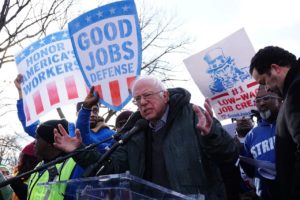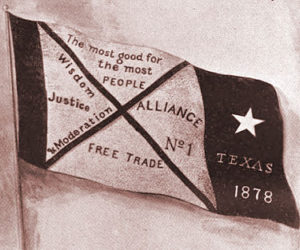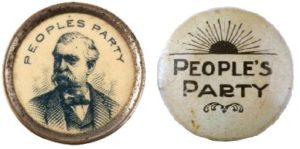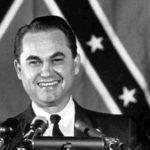Cyryl Ryzak
July 5, 2018

“Populism” is a magical word. Its mysterious power unites the Erdogan and Putin governments, Latin American leftists like Evo Morales and the late Hugo Chavez, the resurgent Right in Europe and the United States, Hungarian and Polish anti-communist parties, Podemos, the Eurocommunism of the tragic Syriza, the revitalizers of social democracy Bernie Sanders and Jeremy Corbyn – all under the same umbrella.

Almost everyone now uses this word in an unthinking way but “populism” is not an innocent characterization. The term has political implications. It gives the discredited “mainstream” politicians of the world, their reputations tarnished by their very real subservience to powerful economic interests, a common fighting cause. What’s more, the continual use of the word is a give-away to the ascendant Right-wing.

When initially described as “populist”, the French National Front at first rejected the term, but after being labeled as such again and again, the FN embraced the term. In effect, writes Anton Jager, “they [commentators] transformed the FN from a fascist party into a populist one.”
The concept’s life purpose is an ignoble one. “Populism” has become a useful shroud for political opportunists. Every player gains from its obscurations except the Left. The so-called “center” can present itself as a necessary bulwark against the Right, while the Right itself can cloak its pathological character in either the righteousness of championing “the people” or the rebelliousness of opposing “the establishment”.
In this division between “populists” and “anti-populists”, the Left is the losing party. When the Right seems on the edge of taking power, leftists are instructed to lend their support to the Clintons of the world. When a socialist party gains some success, however, it is immediately lumped together with xenophobes and chauvinists as “populist”. The very Left-Right antagonism is frequently denied any relevance at all. Instead we hear continually about dichotomies of “pluralism” and “anti-pluralism”, “openness” and “closedness”, “globalism” and “parochialism”.
In an essay for the Guardian, John B. Judis gives a typical precis of “populism”. “Populism” has both a left-wing and a right-wing variant. The former, represented today by Bernie Sanders and Podemos, organizes the “bottom” and the “middle” of society against the “top”, while the latter, represented by Trump and Le Pen, opposes both the “top” and “bottom” from the middle.
Judis treats Left and Right as simply window dressing for the underlying “populism”. This has some superficial truth to it, yet it seems to me to quite a leap to say both are expressions of the same phenomenon. The character of “populists” on the Left and the Right differ fundamentally. They play completely different roles. They relate to the rest of society in different ways. We need go beyond their apparent similarities and grasp what they really stand for.
The Original Populists
The American People’s Party, which is often referred to by the proper noun Populism, is central to Judis’ conception of “populism”. He claims that Populism was the “example [which] would establish the basis for “populism” in the United States and Europe.” George Wallace, his other main historical example, merely “created a new rightwing variety of populism”. This is quite suspect. To see Wallace as simply another version of Populism in rightist disguise because both appealed to the “people” against the “elite” suggests a profound error.
In late 19th century, the American farmer was confronted by the squeeze of the crop-lien system, the rate gauging of railway companies, and a fall in agricultural prices. The old way of life, the familiar rhythms of agrarian culture, the communal bonds holding self-sufficient yeoman together was eroded by an urban, industrial, capitalist civilization. The farmer’s social existence was threatened. With the collapse of their livelihood came the collapse of their entire moral universe.
In the South, the failure of Reconstruction opened the door for Southern conservatives whose grip on Southern society rests on their control of the Democratic Party. These elites ruled over a great mass of poor farmers, whites and freed blacks, tenants and small landowners. In this part of the country, the contradictions of agrarian life were the most acute.

Populism was born of these contradictions. The Farmers Alliance, a mass movement of insurgent farmers, organized cooperatives aimed at the indirect expropriation of the middleman. Farmers united against their impoverishment which was the same as the destruction of their entire way of life. The natural extension of this movement was the birth of the People’s Party.
Populism expressed the antagonism between farmers and the course of social development. It reflected the farmers own contradictory historical position. Nostalgia for pre-capitalist social relations, the allure of prosperity from commercial farming, and the radical potential of the masses define the personality of agrarian movements.
In Populism, progressive demands were cloaked in the language of Jeffersonian restoration, drawing its collective self-understanding from a vision of a true Republic of small producers. Despite the democratic aspects of this ideology, this vision was infused with many accepted hierarchies of home and community and what’s more obscured the real nature of the struggle.
At the same time, the farmer’s inheritance of tradition, prejudice and backwardness was challenged by an egalitarian impulse at the heart of this mass movement. The Populists were not just repeating the perennial pattern of peasant protest, where violations of their moral economy are opposed, but further transformation is avoided. The Populists demanded a progressive income tax and the nationalization of railways. Nowhere else is this thrust felt more than in the Southern Populists’ efforts to overcome racial division and organize black and white farmers together.
The progressive motive force of Populism was the movement from a defensive position of the traditional yeoman farmer into a class politics that challenged the established social order. This motive force, however, was undermined by Populism’s own contradictions. The farmers positioned themselves against outside forces: merchants, financiers, the urban bourgeoisie. Within their own ranks, however, conservative elements steadily ate away at the radical drive. This conservatism did not merely rely on the resilience of tradition but was infused with the vitality of the adolescent capitalist economy.

The farmer’s unity only existed politically. Structurally, the base of the Populist movement was divided between small landowners and prosperous farmers, and poor tenants. The former, geographically represented by Populism’s Midwestern wing, steadily gained control of the party. The farmer’s movement becomes a catalyst for integrating farmers into bourgeois society as just another economic interest fighting for its share of the spoils under the slogan “free silver”.
The Populists joined with the silver Democrats, while the fragile shoots of racial unity in its Southern wing were crushed under the heel of the threatened Southern elite. White supremacy is thoroughly codified in Jim Crow. The South’s power structure is erected on the grave of the Populist promise.
This brief, schematic history of populism illustrates its basic essence: a movement of the masses, with emancipatory potential, undermined internally and externally by the spirit of the times. Can we make the same judgment about Wallace and his supporters?
Was George Wallace a Populist?
To answer this question, the starting point should be the crucial difference between Populism and what Wallace represented. Populism was rooted in a mass movement of class self-defense that for a moment threatened the existing power structure. Wallace, on the other hand, was a figure who embodied in a visceral manner, the pathologies of American life.

Before 1968, George Wallace was just a defender of the threatened Southern order, an enabler of racist violence, and an opponent of the civil rights movement. In this role, he is a pure reactionary, the fiery representative of a legally codified system of racial oppression. It is in the guise he assumes during his 1968 and future presidential campaigns that in the eyes of some earns him the label “populist”.
Wallace skillfully exploited the terrain of American politics. The New Deal, the mass unionization campaigns of the CIO, the mobilization of the Second World War, and the GI Bill resulted in a tremendous improvement in the lives of millions. The reforms of the 30s and 40s, however, were accompanied by the persistence of conservative tendencies: racism, anti-communism, and militarism. McCarthyism marginalized the Left and Taft-Hartley and the bureaucratization of the labor movement put a stop to further mass unionization efforts.
The New Deal order left behind most blacks and a mass of unorganized workers. A sharp division existed in American society between those who experienced social mobility and improvement, and those who were still excluded from the post-war promise. This fostered an illusion that rather than a conquest by the working class and a base for further struggles, the gains won in the Roosevelt era were a fulfillment of a new higher social position, the “middle class”. This feeling was buttressed by racial and ethnic identity. The sudden inclusion and social advancement of blacks via civil rights legislation and affirmative action as well as gains by the multiracial “Other America” via War on Poverty programs was interpreted by the already existing beneficiaries of American public policy as a threat.
This division provided Wallace his base. To call his supporters “white working class” is somewhat misleading. His appeal extended beyond just workers; and even though plenty of wage laborers, a substantial number of whom were union members, supported Wallace, he was not appealing to them as a working class. Wallace’s politics was built on a denial of class identity. Instead, he appealed to the illusion of “middle America”.
The “middle-ness” Wallace tried to harness is not a place in society, but a social practice. To understand the nature of this practice, we need to break with the American liberal idyll of the “middle class”. In this nice vision of security and relative prosperity, the opposition to welfare or support for “law and order” appear as the random frustrations of the average Joe. When one considers, however, a collective emotion like that of the “white backlash”, one needs to uncover its source in the core workings of capitalist economy and society.
The Roots of White Backlash
Pre-capitalist, feudal agrarian systems are held together by traditional, communal, and hierarchal bonds which fix an individual’s place in society. The passage to modernity breaks these bonds. The strict boundaries of rank and estate are replaced with a ceaseless society-wide war of all against all for resources, power, and positions. Alongside this Darwinian contest there exists the stability of a definite class structure. Individuals occupy structural roles: capitalists, workers, various other strata. The capitalist experience is simultaneous the experiences of different classes and a common experience of actors in a competition where everyone feels ripped off in one way or another.
The political consequences of this dual experience can be progressive. Without traditional obscurations, society can appear as it is, a system of naked exploitation. The obliteration of sentimentalities such as the ideal of a caring master or of a dutiful servant means social relations have a more transparent character, facilitating the organization of workers as a class.
But capitalism can also take advantage of its egalitarian aspects. If the charm of feudal hierarchy was like an opiate where serfs could find some bliss in their immobility, bourgeois society intoxicates its members with the possibility of wealth and power. Bourgeois freedom and equality does not just break the bonds of the ancien regime. They democratize the masterdom once reserved for the aristocracy, giving everyone the potential to gain some relative material benefit, exercise some relative domination, and feel some relative superiority over others. Capitalism’s perverse equality is what lay behind “middle America”.
When members of different social classes unite around racial identity to gain a relative advantage over others, they are only intensifying the intoxication. The tendency by some to treat race and class as two separate universes misses this. Both are expressions of capitalist social relations. Class struggle is a pure, demystified, expression of those relations which is why it makes sense to speak of the “primacy” of class. The organization of workers as a class is the first step towards freedom from capitalist drives. Racism does the opposite. It feeds off bourgeois society’s irrationality giving it a more targeted and more terrible form.
The collectivism of the “white backlash” does not require any greater solidarity than that which exists in the everyday experience of life under capitalism. It is a union of extremely narrow, immediate, and destructive self-interests, capable only of triumphing over the socially marginalized. When the Wallace supporter became the Reagan Democrat, the union members among them got what they wanted against the deadbeats and welfare mothers, but in the process they surrendered true solidarity. They were powerless against Reagan’s anti-labor onslaught. “Right-wing populism” always ends in the betrayal of its popular constituencies. This betrayal is nothing more than the logical conclusion of a politics which emphasizes indifference to deprivation and oppression: the real masters find it easier to deprive and oppress everyone.
“Right-Wing Populism” = Organized Chauvinism Not Populism
“Populism” is a very inappropriate term to describe the politics of the Right. Its popular character is a façade masking an acquisitive struggle for dominance. For “left-wing populism”, or simply genuine Populism, the “people” are more than just a random majority. They are united by their downtrodden character. Their common situation of subordination provides Populism its rationale: to end their oppression. Alongside condemnation of exploitation, Populism idealizes the virtues of the common people as the basis for a new egalitarian, moral society.
“Right-wing populism” also idealizes the morals of its “people”, but these morals lose their universal character. They are held as proof of innate superiority, a justification for others’ inferiority and exclusion. In this regard, “right-wing populism” is nothing more than the small man’s aristocratism. Its condemnation of “elites” is empty since its “people” begin to resemble the image of a cruel and detached elite. “Populism” is reduced in right-wing rhetoric to its most superficial features. The “people” lose the solidarity, equality, and morality which genuine Populism invests in them. Instead, they are vessels for a politics whose ends are opposed to those values. This is not to say that Populist movements do not have reactionary features. There is, however, a world of difference between a politics where prejudice is backwardness with a potential to be overcome and a politics where prejudice itself is a motive force.
If Populism must be differentiated from its imitators, it should not be simplistically idealized. Populism has a moralistic character which tries to awaken the pre-existing egalitarianism of the “people”. While it can have tremendous power, morality is often not enough to forge a durable politics which can construct a better social order. Marxism is an advance on naïve Populism since it emphasizes the importance of understanding bourgeois society’s social relations and the classes which inhabit it. For Marxism, society is not static but dynamic and continually changing, driven by contradiction and conflict. Marxism substitutes the working class for the romanticized “people”, not because workers are all noble from the outset but because through organized struggle workers form a conscious, collective solidarity that can act as the basis for reconstructing society.
These criticisms aside, genuine Populism cannot be lumped together with organized chauvinism. Distinguishing between the two is essential. To remain on a level where Bernie Sanders and Donald Trump can both be described as “populist” is along the lines of saying a person is experiencing emotion without specifying whether they are feeling love or hatred.
Cyryl Ryzak is a member of Solidarity living in Portland, Oregon.

Comments
One response to “Populism: What it is and what it is not”
Pretty good. I shared on Facebook. “Populism” as used is often a sneer word by the elites to discredit mass dissatisfaction and opposition to their class rule as just the howling of uneducated yokels, which I wish the article had dwelled on more. Bernie Sanders, whom I admire, does not call himself a “populist,” but a democratic socialist instead, & clearly understands class, class struggle, and class exploitation.